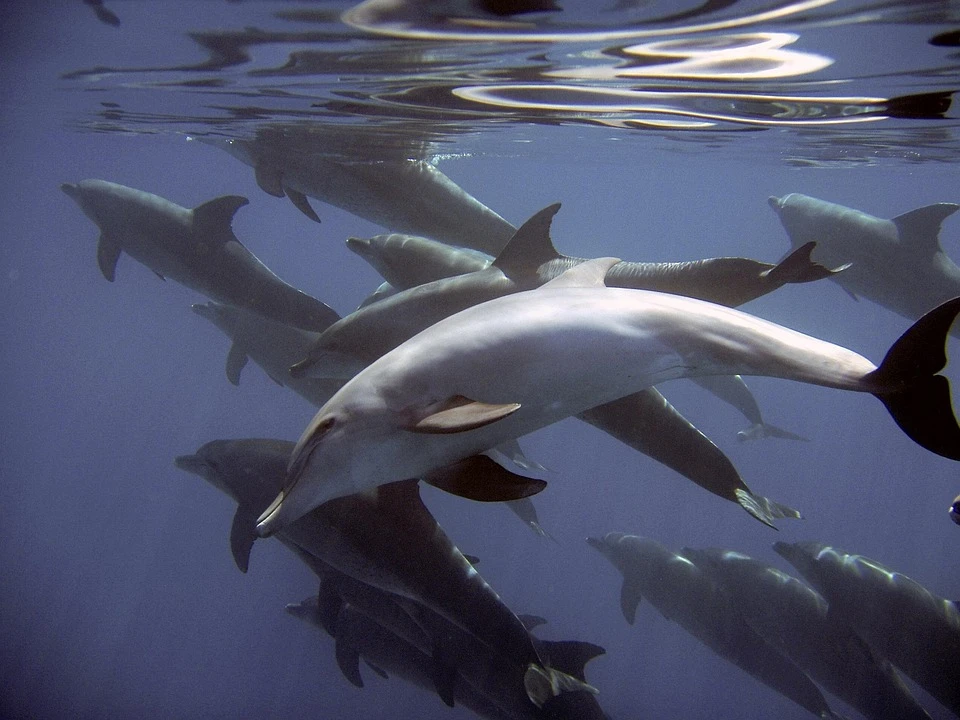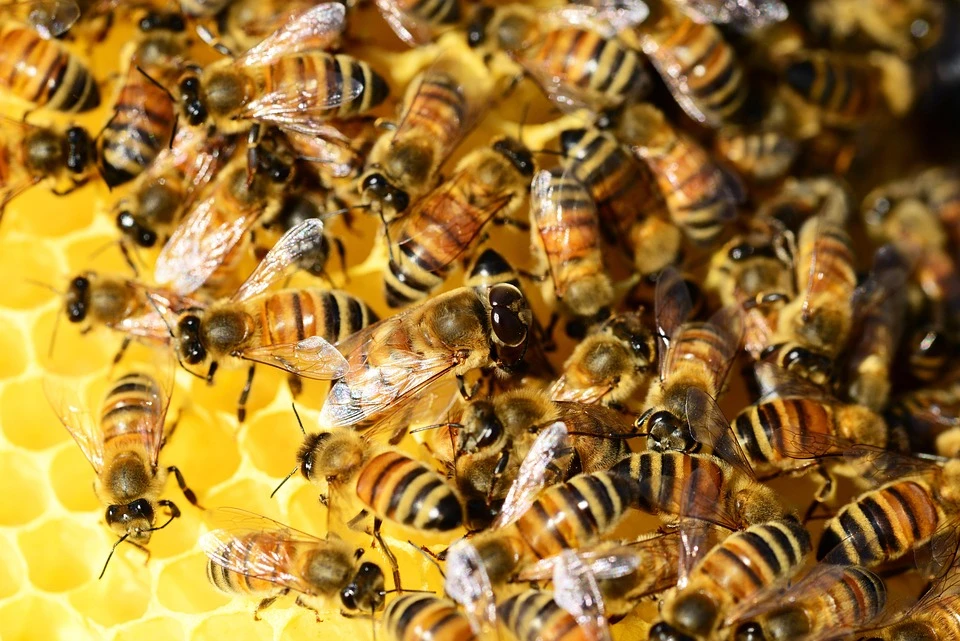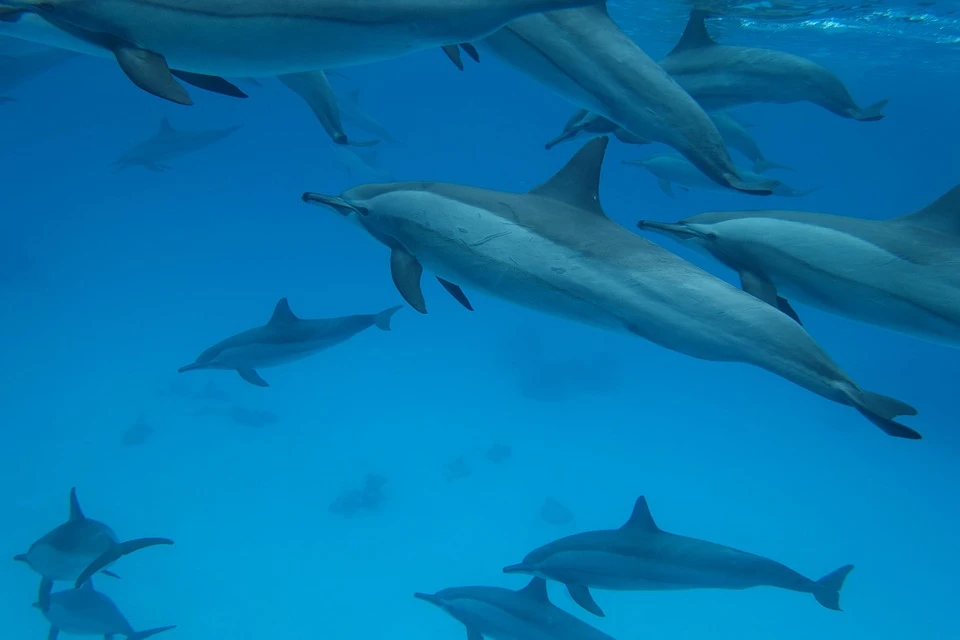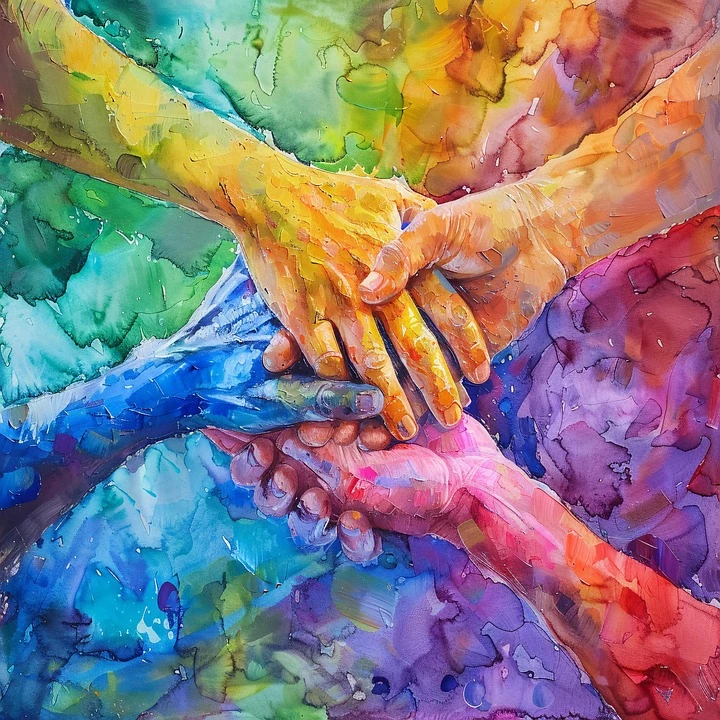image by Rosy Ziegler/Pixabay
article by Root Cuthbertson 2023 ![]()
part of a series on Regenerative Design Principles
"High performing teams believe that if they are successful they will have made a fundamental contribution to their organisation or even to the greater good." – Ken Thompson
Collaborative teamwork is a principle that shows up in living systems in lots of ways. Biomimicry educator Ken Thompson explores many interrelated aspects of what he calls 'Bioteams.' These teams demonstrate several characteristics of living systems, which include being:
- Self-generating. They create their own boundaries, and any components they need.
- Self-regulating. Within their boundaries, they create their own rules and limits.
- Self-reliant. They maintain and sustain themselves, based on a few external inputs.
- Self-organizing. They create and arrange both their own internal structures, and ones that interlink between systems. This includes their own components and processes.
- Self-ordering. They nest themselves, smaller within larger systems.
Boundaries
Like living systems, teams have clearly defined boundaries. A boundary allows a team to limit its scope, to define its own processes, and to clarify its membership. Within its boundaries, a team can self-regulate and self-organize, determining various roles, relationships between members, and expectations around team interactions (see Roles below). For example, some teams are organized by dominance hierarchies, or 'pecking orders,' assigning certain roles to 'stronger' or 'weaker' members. Team boundaries tend to be open to exchange, like permeable membranes, so that the team remains connected to its host community and its wider context (see 3-4 Membranes/Thresholds, see 7-8 Allow Flow).
Shared Goals and Problem-Solving
Most teams focus on achieving a shared goal, solving a problem, or overcoming an obstacle. Here are a few examples of shared goals that teams can collaborate to achieve.
Decomposing – fungi, bacteria, protoctists, worms, and insects can team up to break down dead organic matter and transform it into a multitude of useful nutrients.
Pioneering – re-populating an ecologically disturbed area (like a cultivated field, or the scorched earth after a forest fire) can involve inter-species teams of soil microbes, fungi, bacteria, weeds, and scrubby plants that provide ground cover.
Archiving – Suzanne Simard documents how same-species daughter trees can team up to preserve the 'memories' contained within mother stumps.
Colonies – social insects (like bees, ants, termites, and wasps) use same-species teamwork to build and maintain their nests and hives. Symbiotic colonies of bacteria and yeast (SCOBYs) form inter-species teams for both food production via fermentation, and for defense against extremes in temperature, moisture, and ultra-violet radiation.
Burrowing – prairie dogs, rabbits, and rats often form same-species teams to co-create shared living spaces.
Migrating – same-species teams of birds, butterflies, salmon, turtles, or elephants can help each other migrate. Geese, for instance, collectively remember the entire route, and rotate leadership based on which individual remembers the next segment.



photo by Ted Erski/Pixabay image by Muhammad Shahzad Butt/Pixabay image by Muhammad Shahzad Butt/Pixabay
Shoaling, Flocking, Herding – small fish, birds, and hoofed mammals (like bison, horses, antelope, caribou) often team up to travel in same-species groupings. Sometimes inter-species teams (like zebra and wildebeest) form to enhance protection from predators.
Hunting – orca pods and wolf packs form same-species teams for hunting prey. Inter-species teams of coyotes and badgers have been observed hunting ground squirrels.
Networking – Clustering - Nestedness
A network of teams, or a host community like an ant colony, might approach a large complex problem (collecting and storing an abundant food supply; or repairing a damaged nest) by breaking it into smaller tasks that are then assigned to a number of teams. Each team would have its own particular task, while also working alongside all the other teams to achieve the shared goal of the host community. Each team can also devise its own strategies for achieving their task, so each team's approach may vary (see Strategies and Processes below).
Dolphin pods provide a good example of the clustering aspects of collaborative teams. Most of the time, dolphin pods are strongly-bonded coherent teams, where members regularly work together. Occasionally, dolphin pods can cluster into weakly-bonded super-pods; as when feeding on seasonally massive shoals of fish, or when socializing with distant 'cousins' from far away.
Dolphin pods are able to maintain both a (weaker) connection to a larger cluster (or super-pod), and a simultaneous (stronger) connection to their regular pod. This allows for some fluidity and agility, both throughout the network and within the team. Dolphin pods might occasionally cluster for family reunions, or to visit with friends whose company they enjoy. Individuals might occasionally swap pods (like foreign exchange students), to see what it's like in another pod, or to get more time with a certain sexy someone.

photo by joakant/Pixabay
Individuals who have lots of relationships (sexy or otherwise) help increase the connectivity of the network. It is often highly connected individuals who help their pod (or team) engage effectively with the wider network (see 1-7 Networks). This can assist with 'bridging,' keeping a team up to date with what's happening in the network, and helping to align a team's activities with the overall goals of the host community. This relates to the principle of Nestedness. Much as individuals are nested within a team, teams are nested within a larger host community, all working together toward a number of shared goals. In this way, a team resembles a holon nested within a holarchy (see 1-2 Nestedness). This nested and networked connectivity affects several other aspects of collaborative teams.
Modularity – Redundancy – Trusted Competency
Within a larger network, teams can become a form of modularity (see 3-2 Modularity, see 1-7 Networks). In an ant colony an overall shared goal of collecting and storing food might be modularized: some teams might work on collecting, while other teams work on storing food. Storing food might be further modularized into several areas, each with a distinct team. All the food-storing teams might begin with a similar basic approach or technique, which can help teams trust each other to accomplish their tasks efficiently and effectively. It turns out that trusting the competency of fellow teams within the same host community can be really important, affecting team autonomy and self-management (see Autonomy below).
One of the benefits of modularity is redundancy in case of failure. Even if one module fails, the entire network can continue. Redundancy can mean ensuring multiple teams have similar skills and knowledge. If one food-storing team's performance is reduced by illness or injury, another team with similar knowledge of basic food-storing techniques can step in as a substitute. They have a trusted competency with the same basic food-storing techniques. Work toward the overall goal of storing food can thus continue, even though one team is taking a break to rest and recuperate; maybe even getting a few new members (see 7-6 Resilience/Redundancy; see 4-7 Ecology of Support).
Over time, modularity can also lead to slight variations or specialized techniques. One food-storing team might 'improve' on the basic technique by using a certain leaf or a sticky gum. At first, such an innovation might not be communicated, especially if everyone is really busy. Also it can be helpful to wait and see if an innovation actually turns out to be a successful improvement. Eventually, if an innovation is proven beneficial, it is typically shared widely with other teams (see 8-5 Replicate Successful Strategies; see 6-5 Systematize Strategies). While among humans, innovations might be 'jealously guarded,' the opposite is typical for most non-human collaborative teams, where it is more common to prioritize sharing proven innovations that benefit everyone (see Innovation below, see Shared Work and Wealth below).
Size and Scale
Teams are most effective when they are the 'right size' for their task. For example: while there can be 'too many cooks' in a kitchen trying to prepare a meal, there can also be not enough helpers. The size of a team can change, depending on the size of the task. While a smaller team can prepare a family sized breakfast, a neighborhood celebratory feast might benefit from a larger team. Team size can also adjust along with natural cycles of growth and decay. During an abundant harvest season, a kitchen team might expand from cooking meals to processing, preserving, and storing food. During a quieter winter season, a kitchen team might shrink back to simply preparing meals.
Humans typically benefit from the group dynamics of a small team. In a smaller team it can be easier to feel like you've made a meaningful contribution, to see the results of your efforts, sometimes tangibly. Smaller teams can also allow for more innovation and individual expression. Small teams can provide some 'division of labor,' with members focusing on different roles or aspects of a shared goal. For example: a team producing an event might divide into roles responsible for – welcome and orientation; logistics and registration; overview and budget; practicalities and infrastructures; reflection and review; entertainment and catering (see Tasks below; see Roles below).
Coordinating all these various tasks and roles, especially when teams are nested within a larger network, becomes an important part of a larger group dynamic. Humans can also benefit from feeling part of something larger. Networked teams can coordinate to expand the reach and range of their efforts and thus achieve shared goals on a larger scale. For example: a small honeybee hive might start out with 5k workers with a limited range, and then expand to 10k or 20k workers with a much wider range (see 6-7 Change Scale). Team coordination of harvesting nectar might involve the most efficient way to cover different geographic areas (see Coordination below).
Distributed Leadership
"It pays to take turns doing the hard tasks and sharing leadership." – Angeles Arrien
Angeles Arrien has described a number of lessons we humans can learn from how migrating geese distribute leadership in collaborative teams. Teams of geese fly in V-shaped formations, which is hardest for the lead goose, who does not benefit from the extra lift enjoyed when flying behind another's slipstream. By rotating leadership, geese take turns flying in the more difficult lead position, then falling back in the formation to fly with less effort. This helps to conserve everyone's energy and allows a team of geese to fly further than a single goose can fly alone. Distributed leadership also allows a team of geese to collectively remember the entire migration route.
No one goose knows the whole migration route. Collectively, between them, they know the migration route but no one individual knows. So a goose leads the part of the journey where it knows the way and when it recognizes “I don’t know where to go next” it flies back into the V and waits for another goose to take over. – Ken Thompson
Teams that rely on either collective memory or collective intelligence trust in the competency of each team member. Team members are trusted to take the lead, especially when they have a 'bright idea' or 'remember the way.' Some teams even allow any member to take the lead, especially if that member has helpful information about a local context, or connectivity with the wider network of a host community (see 7-7 Self-Organize). This can reinforce what Thompson calls an 'action bias:' if they prefer to continue working as much as possible toward achieving their task, high performing teams can rotate leadership to be most effective. Such strategies have allowed generations of geese to collaboratively achieve their shared goals.

photo from Pixabay
Autonomy and Self-Management
In high performing teams, an 'action bias' supports the tendency for taking action. Instead of deliberating or waiting for permission, both teams and individual team members are empowered to respond swiftly to certain situations. When there is trusted competency, and access to accurate information, everyone can make well-informed independent decisions and enjoy a degree of autonomy. Such decisions are often based on a simple set of agreed rules – usually about how to act in case of threat (predator or competitor) or opportunity (food or building materials). For example, when an autonomous forager discovers a valuable resource and communicates an 'alert,' the rest of the team can begin mobilizing to respond in agreed ways. Communicating transparently and sharing information thus become vitally important, since they are linked to rapid responses and independent actions (see Communication below).
Self-management benefits all levels of a networked system, both teams nested within a host community, and individual team members nested within a team. Timely access to accurate information supports self-management, while reducing the need to ask for permission or await commands.
Caution! Hazard: if you were raised in a westernized society, you may be most familiar with dominance hierarchies where managers use a predict-and-control approach with workers. This has happened a lot. Workers in such systems get used to asking for permission or awaiting commands. They are typically treated like cogs in a machine, without any expectation of developing autonomy, nor any personal accountability for independent decisions.
In high performing teams, individual members are expected to develop autonomous behavior, which tends to reinforce a group culture of personal accountability. Individual follow-through on tasks in support of the team's shared goals makes self-management much easier. Some human teams even support self-management by keeping track of everyone's actions and having regular review sessions (see Accountability below).
Team Strategies and Processes
When teams are trusted and enjoy autonomy, they tend to come up with their own strategies for achieving their tasks. While a network of teams may generally agree on a shared goal, the exact strategy for how each team goes about achieving that goal (or their particular task) is largely left up to the team. This pattern holds within teams as well: if each team member is trusted to act with competency, and has access to relevant information, and is in regular communication with others, they can be trusted to 'get on with tasks.' Teams can thus determine and evolve their own strategies for approaching and accomplishing tasks, making numerous small decisions independently.
"Strategy happens organically, all the time, everywhere. Decisions are frequent, small, imperfect, independent, local, and constantly updated." – Tamsin Woolley-Barker
Team strategies can be either internal or external facing. External strategies involve how the team interacts with the world outside the team itself. These might include foraging for food or resources, scouting, posting a lookout, reporting back to the team. Such strategies often involve using a team's collective intelligence to solve problems, or finding ways to leverage collective abilities to accomplish tasks productively. Where a single ant may not be able to retrieve a valuable resource, a team of ants may. External strategies may also include competitive interactions (like avoidance, tolerance, or aggression); or cooperative and helpful interactions that support alliances. A dolphin pod may avoid orcas; or show aggression toward sharks; or cooperate with whales so that everyone benefits, now and in the future.
Internal strategies involve processes that affect the interactions within a team. These might include idea-generation, workflow, meeting practices, or resolving internal conflicts. Thompson uplifts a common personal strategy of reciprocity, which he calls 'tit for tat': if I support you one time, you'll support me next time. Other internal processes include recruitment of new members; training in new capabilities; design, creation, and maintenance of new infrastructures (like communication or transportation systems); regular review of team strategies (including innovations, adaptations, or specializations) to improve productivity or success rates.
Tasks – 4 types
Ken Thompson outlines 4 ways teams commonly strategize to accomplish tasks. Depending on the context, a team might try any one of these approaches or a combination.
- Crowd work (same task, same time) – several individuals can work together on the same task at the same time. For example: flash mobs, ideation sessions, review meetings, transporting a heavy object.
- Group work (different tasks, different times) – teams can create a sequential division of labor. For example: assembly lines, registration then orientation, collect then store food, non-synchronous document editing.
- Solo work (same or different tasks, same or different times) – tasks can be completed by single individuals without help. For example: preparing a family meal, drafting a document before sharing, foraging.
- Team work (different tasks, same time) – several individuals can work on different tasks at the same time, requiring coordination. For example: a coordinated response to threat or opportunity, building projects, cleaning a living space, tending a garden.
Coordination
Coordination within or between teams can increase effectiveness and efficiency. For example: a honeybee hive is a network of teams with the shared goal of collecting and storing food. Teams can coordinate their efforts so that one team does not 'waste time' trying to harvest nectar from an area that has already been harvested by another team. Honeybees regularly communicate updates about which areas have already been harvested, and which areas currently have an abundant supply. Coordination can help teams more productively accomplish tasks, by avoiding the confusion that can ensue from overstepping boundaries. In this example, each team might have a specific geographic boundary, the area it has been tasked to forage. Coordination might look like respecting each team's sphere, trusting each team's competency and self-management to accomplish their particular task and contribute meaningfully toward the shared goal.
Coordination can also be helpful within a team. A hunting wolf pack might coordinate relative locations so as to channel prey in a certain direction. Prairie dogs might coordinate burrowing to prevent tunnel collpase. Any building project (like a beaver dam, wasp nest, or a fungal mycelium) might coordinate 'collaborative editing' to include additions or deletions contributed by each member. This allows everyone to make adjustments to each other's work, so that the final outcome benefits from the collective intelligence of the team.
Communication
If teams are expected to simultaneously make autonomous decisions and efficiently coordinate their efforts, they must have excellent forms of communication. Thompson argues that high performing teams rely on 'total transparency:' timely and honest communication of any important information. This contributes to everyone's ability to make informed decisions, and thus to autonomy and distributed leadership. Transparency is greatly assisted by developing the communication infrastructures that affect how information flows or gets stored; or that affect transmitting and receiving on specific channels or frequencies. Humans might use devices like intercoms or walkie-talkies; dolphins and whales use sonar; ants and bees use pheromones.
Ken Thompson describes communication at three levels. An individual can communicate 'privately' to one other individual; an individual can 'broadcast' a message to the entire host community; or an individual can 'broadcast' indirectly to the surrounding environment where the message will disperse even more widely. Communication is mostly transparent to everyone: ants and bees can't hide pheromones once they've been released; aquatic audio messages 'broadcast' by dolphins and whales are transparent to everyone.


photo by PollyDot/Pixabay photo by JD Truchement/Pixabay
Whole-group broadcast messages, that can be instantly transmitted and received by any team member anywhere, tend to convey information, not commands. They serve as one-way messages which can be acted upon as soon as they are received. They tend to be short and simple 'alerts' about threats or opportunities. Teams that have previously agreed ways to respond to such alerts can increase their effectiveness and the speedy coordination of their efforts. Teams might develop their own etiquette around broadcasting, or defining what kinds of behavior are appropriate or helpful upon receiving different kinds of alerts.
In human teams, communication is usually affected by several other factors. Many humans are used to dominance hierarchies where relationships are competitive, secret scheming is expected, honesty or dishonesty can be either rewarded or punished. Communications that are not transparent to everyone can lead to speculation: what did those two say? why are they keeping secrets? are they making plans to disadvantage us? Humans can spend lots of attention and energy mistrusting each other and intentionally miscommunicating. Teams that increase trust can free up lots of attention and energy for more truly helpful activities.
Roles – Commitment - Accountability
Much like how a network can self-organize by dividing a shared goal into tasks taken on by a number of teams, a team can self-organize by dividing into a number of roles taken on by individuals. It helps coordination, and avoids confusion, when roles have clearly defined boundaries, responsibilities, and expectations around interacting with other roles (see 2-1 Niches/Roles). In high performing teams Thompson notes that roles are defined less by achieving results and more by relational interactions. For example: honeybees clearly define several roles and their expected interactions: Guards are expected to allow entry to Foragers; Foragers are expected to provide nectar to Food-Storers; Food-storers are expected to secure nectar in Fanning areas; Fanners are expected to reduce nectar moisture to make honey; Nurses are expected to feed honey to Infants; Infants are expected to grow and mature into healthy adult workers who can take on a role.
An individual may be expected to commit to a certain role for an agreed amount of time. Commitment includes a focus on achieving the team's shared goal, as well as the particular responsibilites and expectations of the role. Role commitment allows a team to try out a certain configuration for a time and see how it goes (see 3-1 Rotate Roles). This can increase stability within a team (see Stability below). While individual focus on one role is common, some teams expect everyone to contribute ideas or feedback about any role, how it affects other roles, what adjustments might lead to improvements. The quality of role performance may vary by individual: one may be perceived as 'better at' a role than another. Perceived deficiency in role performance may be a subject of tension, conflict, or discussion during ideation sessions or team reviews (see 3-3 Feedback).
Ken Thompson proposes that high performing teams include clear, public, and transparent ways to hold every individual member accountable, especially once they have committed to a role. In human teams, this might look like keeping track of everyone's actions, and regular meetings or updates on processes and priorities. Accountability ensures that roles are performed adequately, agreed strategies are followed, milestones are reached, and that everyone is participating, so as to reduce free-riding or cheating. Instead of relying on domination or hierarchical authority, accountability can rely on the desire to maintain a positive reputation and good relations with others. Teams can increase performance and productivity whenever all team members trust each other. Individuals who follow-through on their tasks develop a good reputation as someone with trusted competency who can be relied on. Team members who perform less well might receive feedback about how they could improve (see 3-3 Feedback). This can help individuals increase self-awareness, supporting personal growth and development alongside overall team effectiveness (see 6-1 Maturation).
Diversity – Experimentation – Innovation
While teams usually find it desirable to have a degree of conformity around agreed processes and their shared goal, teams can also benefit from a degree of diversity. Human teams might develop their own internal processes around negotiating differences of opinion, or resolving conflicts between team members. These might arise during ideation sesions about how to best approach a particular task or problem, or how to improve someone's role performance (A 'young buck' might challenge an 'old stag' to lead the team in a different direction). Autonomy and modularity can lead to specialization in diverse approaches to achieving a shared goal. When problem-solving, individual team members might be encouraged to 'think creatively' to develop new ways of doing things that differ from previous ways. To replace older members as they retire, many teams regularly admit new members who may have fresh or differing perspectives. Newcomers may lack awareness about traditional team processes and invite questions about approaching them differently. Teams that cultivate diversity and creativity may eventually end up integrating new approaches or ideas (see 2-7 Diverse Expression, see 4-8 Integrate the Unexpected).
Self-managing teams often use experimentation to develop their own strategies, informed by what Thompson calls an 'action bias.' Instead of abstract deliberation or over-planning, such teams conduct real-world experiments, using a process of trial and error, 'rapid prototyping,' and consistently following simple rules. This can take some time. By allowing time for this process, teams can refine their strategies and produce effective solutions to complex problems. Because not every prototype is immediately successful, a prudent team adopts a 'wait and see' attitude. During a trial period, all team members might be invited to suggest improvements to a prototype via 'collaborative editing.' A prototype might go through several iterations (a version 2, version 3, and so on, similar to software releases), until the team is satisfied that it is in fact beneficial, tried-and-tested for real-world application.
Once a new idea or approach has been proven beneficial, a team commonly shares that innovation more widely. This is an important way that learning can lead to change in many living systems. At first, due to nestedness, a shared innovation might only affect neighboring teams, clusters, or modules. The most appealing innovations might spread throughout an entire host community or network. Such innovations might eventually become systematically normalized and passed on to future generations. This might look like being encoded in the DNA, or in a species' particular abilities, habits, or behaviors. Living systems, which are based more on cooperation than competition, rarely hoard beneficial innovations or reserve them for a single team (see Sharing Work and Wealth below). This relates to several principles covered elsewhere (see 8-5 Replicate Successful Strategies; see 6-5 Systematize Strategies; see 6-6 Lifelong Learning; see 5-2 Past Informs Future).
Emergence – Adaptation
The creativity that self-managing teams use to develop their own strategies can lead to rapid responses and unexpected innovations. Promoting a flexible attitude of 'expecting the unexpected' allows a team to better respond to unpredictable situations. For example: if unpredictable weather patterns result in an early flower bloom, a colony of bees might organize an early harvest. Many aspects of living systems that are typically predictable can become unpredictable. New patterns can emerge from unexpected changes. A change in weather might affect the timing of a migration, or the blockage of a familiar pathway, or the movements of a herd or shoal, or the patterns of hunters or foragers. While teams can expect such changes to happen, and prepare to a degree, no one can predict with certainty exactly what will happen, or what new patterns may emerge. It can be diffcult to predict how changes, large or small, might affect a team, its host community, or a wider network. The same attitude of embracing experimentation, protoyping, and creative problem-solving can help teams respond to the unpredictability of emergence. In human teams this can look like flexibility. A team can keep its strategy or approach flexible enough to be adjusted if circumstances change, or if something unexpected emerges. More on this elsewhere (see 8-8 Allow Emergence; see 6-8 Allow Change; see 4-8 Integrate the Unexpected).
In teams, as in networks, innovation often occurs at the margins. Newcomers may bring with them new ideas. Marginalized team members may make adjustments that more mainstream members don't. The margins are places where living systems interface with the most diversity, where changes and adaptation to changes are most necessary (sometimes due to emergence), and thus most common.
"Teams adapt to change at the edges, all the time, in little bits of work done by everyone." – Tamsin Woolley-Barker
Teams can recognize this and develop processes for such changes to become tried, tested, improved, integrated, and normalized. A systematically normalized innovation, widely adopted throughout a network, can become an adaptation. Adaptations are often answers to a strategic question: How to conserve body heat in the winter? How to move efficiently through water? How to migrate thousands of miles every year? How to support those who have asked for help? Adaptations can become encoded so as to be passed on to future generations, either via biological genes (DNA) or cultural memes (behavior). Over time, the collective remembering and expression of such adaptations affect learning, growth, development, and evolution.
Stability and Group Cohesion
Caution! Hazard: if you were raised in a culture that is more risk-averse, or if you have negative experience of instability (like living with the threat of armed conflict), you may have some bias about stability. This has happened a lot. You may prefer when things are more certain and stable; and you may feel uncomfortable with uncertainty. You may favor things that seem to increase stability, and disfavor anything that seems to reduce stability. You may use either-or terms like 'us or them,' 'black or white.' You may strongly disagree with those who see 'shades of grey.' You may struggle to understand relativism, or how any situation could possibly be 'both-and.' Living systems benefit from both adaptability and stability. Living systems grow and develop over time; and adapt in response to changing conditions. And, stability helps a living system maintain core aspects of its characteristics and behavior, allowing relationships and connections to establish and become truly supportive.
The stability that arises from a period of consistent membership allows the small group dynamics of a team to reach a 'high performing' stage, when all team members are confident and comfortable in their roles. Everyone knows what to do, and how to do it. Tasks are accomplished, goals are achieved, everyone is satisfied with how things are going, everyone benefits. Stability can also benefit collective memory, when some (or even all) members remember previous processes and agreements. There is no need to 're-invent the wheel,' nor any newcomers (with new ideas or lack of awareness) to orient. Periods of stability support productivity and group cohesion.
Caution! Hazard: if you were raised in a modern westernized society, you may have limiting beliefs about group cohesion. This has happened a lot. You may not have had many positive role models, or only witnessed teams based on dominance hierarchies. You may have a dismissive attitude, like 'it never lasts,' or 'it's doomed to fail.' You may hold a socially conditioned belief that individualism is correct or inevitable, and that it will always trump any collective attempt at group coherence. This can be viewed as one extreme of an 'individual-group' polarity. The other extreme has similar limitations. A group can over-emphasize collective well-being and severely restrict individual expression. Groups can become over-invested in collective decision-making, leading to paralyzing 'group-think' attitudes and behaviors. A more connective approach would aim to balance this 'individual-group' polarity, either simultaneously or sequentially.
Teams usually benefit from the 'right amount' of group cohesion. Too much can result in a rigidity that reduces creativity and autonomy – 'group-think' dominating diversity and experimentation. Too little can result in a looseness that reduces efficiency and productivity – tasks getting done slowly, sloppily, or not at all. This can also endanger individuals – straggling away from the herd makes you more vulnerable to predators – or endanger a larger group. A bee colony can only survive the extreme cold of winter by sharing body heat in a large coherent group; smaller or looser clusters would not survive.
A team typically develops group cohesion by first building trust among team members. In human teams this might look like certain practices used during meetings: having a 'check-in,' or a 'weather report;' normalizing how to offer feedback; 'sorting tensions' or tending conflicts by ensuring everyone is 'clean and clear' with each other. Human teams also benefit from being motivated to focus on their shared goal, and reminded about shared values. Over time, such practices tend to strengthen relationships, increasing team members' willingness to take risks with each other, and increasing a sense of interdependence. In a network of teams, group cohesion might look like a dolphin 'super-pod', an ant colony 'super-organism,' or an oak tree as a 'holobiont' (see 1-5 Interdependence). When such networks span large distances, they may even resemble communities of practice (see 2-5 Webs of Belonging).
In human teams, Ken Thompson suggests that the 'right amount' of group cohesion can show up as:
- Looking out for each other's well-being.
- Expecting to share equally in any team achievement or adversity: “One for all, and all for one”.
- Perceiving each member as accountable to all the others.
- Staying motivated by perceiving their shared goal as important, worthy, or meaningful.
- Maintaining optimistic, resilient, 'can-do' attitudes about achieving their shared goal, despite adversity or setbacks.

image by TyliJura/Pixabay
Sharing Work and Wealth
Team members can support each other by sharing in various ways. Reciprocal relationships are reinforced when individuals support those who have previously supported them. Team relationships benefit from sharing in a balanced or equal way. A sense of giving and receiving equally can increase trust and group cohesion. Among humans, this might look like each player on a football team getting an equal amount of on-field game time. Or everyone might be asked to contribute equally to a task, instead of 'higher-ranking' and 'lower-ranking' individuals contributing more or less.
Team members can also support each other by asking for help, giving and receiving it. Teams might develop various group cultures around asking for help. Some human teams view asking for help as a way to renew relationships, to participate in a continuous flow of reciprocity. Because last time I asked for your help and you gave it, I now owe you a debt. When you ask me for help next time, the strength of our relationship means that you can count on me to respond positively. When I give you help, and you receive it, this renews and strengthens our relationship. I may even over-compensate slightly, so that you now owe me a debt. That way, we can both look forward to the next time I ask for your help.
Team members believe that if they need help they can ask for it and it will be freely offered. They believe that asking for help, in moderation, actually increases their standing within the team rather than diminishing it. They also believe something is badly wrong if somebody is struggling along and not asking for help, or is asking for help but being ignored by the team. – Ken Thompson
The principle of Collaborative Teamwork uplifts the values of reciprocity, social connection, and mutual aid. Long-term relationships are valued more than short-term transactions. Any interaction that might end a relationship or sever a connection is considered dangerous or undesirable. Individuals are encouraged to contribute toward team wellbeing, or to the 'common good,' as a form of mutual aid. This might look like supporting each other's basic needs, sharing work, reciprocating, exchanging resources or services, sharing equally in whatever benefits the team accumulates. Such shared wealth might be tangible (food, medicine, shelter) or intangible (knowledge, skill, wisdom). This is why teams that are part of a network typically share any innovations that prove beneficial. If all networked teams are encouraged to share anything that might benefit everyone, then the entire network is more likely to benefit, including every individual (see 4-5 Collective Responsibility).
This aspect of Collaborative Teamwork relates to the princple of Interdependence, or mutually relying upon each other (see 1-5 Interdependence). Teams can have low, medium, or high levels of interdependence. Thompson argues that those with lower levels tend to be least effective and productive; while the highest performing teams have the highest level of interdependence. When team members consistently rely upon each other for help, well-being, and shared benefit, they tend to trust each other more, and are more willing to take risks for each other. When my well-being is mutually entangled with yours, it makes sense to share our work and wealth.
'Collaborative Teamwork' and 'Cooperation' are related yet distinct principles. Cooperation can be viewed as a longer-term relationship, typically formed between two or more species. For example, flowering plants and their pollinators have co-evolved to cooperate long-term, over multiple generations of each species involved. Cooperation can involve two unrelated species becoming entangled in each other's long-term wellbeing and survival (see 1-4 Cooperation). While forms of inter-species teamwork do happen, the principle of Collaborative Teamwork is most often seen in same-species teams. Teamwork can be viewed as a typically shorter-term same-species arrangement for achieving a shared goal. Teams might form for a season, or an individual lifetime, or only until a goal is achieved. Compared to long-term cooperations, which rely on stability and consistency, teamwork arrangements can be more flexible so as to more rapidly respond to changing circumstances or unexpected emergence.
Designing with Collaborative Teamwork in Mind
The principle of Collaborative Teamwork can inform designers in some very practical ways.
- Build trust. Foster a 'one for all and all for one' attitude of mutual support (see 4-7 Ecology of Support).
- Design for transparent communication. Support honesty, feedback, and optional instant whole-group messages (see 3-3 Feedback).
- Design for the right size, scope, and scale. Plan for how a team might grow or modularize (see 6-7 Change Scale, see 3-2 Modularity, see 3-5 Strucutural Integrity/Limits to Growth).
- Design for the 'right amount' of group cohesion. Avoid both rigidity and looseness (see 7-7 Self-organize).
- Distribute leadership, commit to roles, share accountability. Clarify role boundaries, reponsibilites, and how they are expected to interact with others (see 2-1 Niches/Roles, see 3-1 Rotate Roles, see 4-5 Collective Responsibility).
- Design for some autonomy (trusting everyone's competency) and some coordination. Trust members to 'get on with tasks', while communicating and sharing updates (see 6-4 Empowerment).
- Design for redundancy. In case of illness or injury, allow for substitutions. Plan for replacements (see 7-6 Resilience/Redundancy).
- Develop strategies to achieve your shared goal. Encourage creative problem-solving and innovation (see 4-8 Integrate the Unexpected, see 6-5 Systematize Strategies, see 6-8 Adapt to Change).
- Rapidly prototype. Experiment with real-world solutions for a trial period. Invite feedback, make improvements, and replicate successes (see 7-2 Experiment in Low-Risk Contexts, see 8-5 Replicate Successful Strategies)
- Leave space for emergence. Make a plan ahead of time, and don't be super attached to every aspect of it. 100% of your plan may not happen exactly as you planned. Be prepared to adjust the plan in response to new information or changing real-world situations (see 8-8 Allow Emergence)
- Stay motivated, resilient, and optimistic.
"Never doubt that a small group of thoughtful, committed, citizens can change the world. Indeed, it is the only thing that ever has." – Margaret Mead
Questions to Consider:
How have you experienced teamwork? What teams (groups working to achieve a shared goal) are you currently part of?
How do you show that you trust someone's competency? How do you prefer someone to show that they trust yours?
Who do you trust to lead a team? Why? When might you step into a team leadership role?
How do you feel about committing to a role? What sorts of roles are easier to commit to? Harder?
What is your relationship to personal accountability? How has accountability shown up in your life?
How do you feel about taking risks? About leaving space for unpredictability?
What is your experience of transparent communication? How comfortable are you with offering your opinions or feedback to others? With receiving feedback?
Which of the team strategies and processes mentioned here feel familiar? Which feel edgy? Which are you curious to try?
References
Arrien, Angeles (1991). "Lessons From the Geese." https://www.toolsforchange.org/wp-content/uploads/2013/10/geese.pdf
Hofstede, Geert. (2003). "Six Dimensions of Culture." https://geerthofstede.com/
Simard, Suzanne (2021). Finding the Mother Tree: Discovering the Wisdom of the Forest. Knopf.
Thompson, Ken (2005). "Key Traits that Characterize Successful Bioteams." https://bioteams.com/2005/04/06/bioteaming-a-manifesto.html
Thompson, Ken (2005). "The Seven Beliefs of High Performing Teams." https://bioteams.com/2005/08/29/the-seven-beliefs.html
Thompson, Ken (2006). "Teamwork: Learning From Dolphin Pods." https://bioteams.com/2006/01/24/teamwork-learning-from.html
Thompson, Ken (2008). Bioteams: High Performance Teams Based on Nature's Most Successful Designs. Meghan Kiffer Publishing.
Thompson, Ken (2014). "The 4 different types of Teamwork in Nature." https://bioteams.com/2014/09/25/top-teams-understand.html
Wikipedia. "Mutual Aid – Organization Theory." https://en.wikipedia.org/wiki/Mutual_aid_(organization_theory)
Wikipedia. "Reciprocity – Social Psychology)." https://en.wikipedia.org/wiki/Reciprocity_(social_psychology)
Wikipedia. "SCOBY." https://en.wikipedia.org/wiki/SCOBY
Wikipedia. "Teamwork." https://en.wikipedia.org/wiki/Teamwork
Woolley-Barker, Tamsin (2017). Teeming: How Superorganisms Work to Build Inifinite Wealth in a Finite World. White Cloud Press.
Root Cuthbertson
loves dancing, music, poetry, public libraries, matching needs with resources, monofloral honeys, generously inclusive humor, and stories about healing and hope. He has studied social change movements, comparative religion, needs-based approaches, de-colonization, and liberation for all. He holds a Master’s Degree in Environmental Education, and certificates in Sustainable Curriculum Design, Participatory Facilitation, and Ecopsychology. A certified trainer in Gaia Education eco-social design, Root designs experiential opportunities for learning by creating strong containers for the graceful facilitation of group energy. With his wife Deborah Benham, he has delivered trainings on Sociocracy, Culture Repair, and the Connection 1st online courses: “Introduction to Regenerative Community Building,” “Designing for Peace,” and "Pathways to Village Building.” Former Training Coordinator for Transition Network, he is the co-author and curator of collections on Personal Resilience, Conflict Resilience, Group Culture, and Social Justice. With Jon Young and Deborah, he is co-authoring a series of e-books on regenerative community design. With his ear to the ground, Root’s guiding question is: “What is most needed here now?”
![]()

